Cutting boards are handy kitchen tools. A good cutting board will help you cut all kinds of ingredients such as meat, fish, vegetables, and fruits. There are many types of wood used to make cutting boards and one of these is mahogany.
Is mahogany good for a cutting board or would you rather use other woods for this task? Let’s find out in this mahogany wood guide.
Mahogany Good or Bad as Cutting Boards?
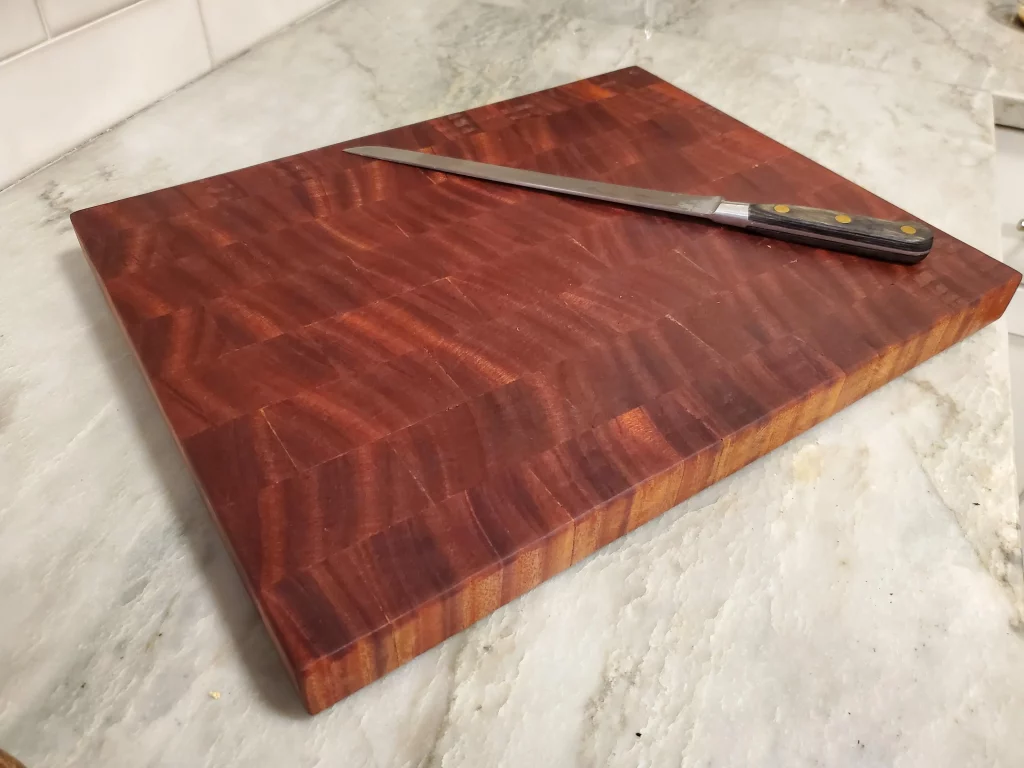
Mahogany wood is strong with a good compressive or bending strength making it great for cutting boards. This wood is hardwood but despite this, it is softer compared to other hardwood species used as cutting boards like maple.
The Janka hardness test reveals that Mahogany has 830 pounds-feet hardness compared to maple which has 1450 pounds-feet hardness. This is higher than mahogany which means cut marks on mahogany cutting boards will be more visible compared to maple cutting boards.
The cutting board surface becomes very vulnerable to marring and scratches because of repeated movement of knife edges. Because of the visual marks on the surface, many woodworkers and kitchen workers don’t use mahogany cutting boards.
Another characteristic of mahogany is that it has an open grain. This means that the pores structure is bigger that even dirt and dust become trapped in mahogany boards. There is also a possibility that bacteria and other microorganisms can become trapped inside these pores. This can lead to severe health issues.
According to woodworkers, mahogany cutting boards are great, but they prefer other materials. They may recommend using these cutting boards as decoration only.
Characteristics of Mahogany Wood
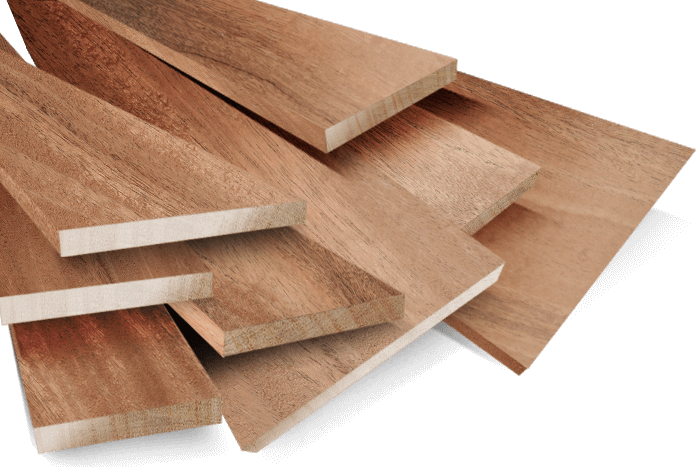
Mahogany is a wood with a straight grain and reddish-brown surface with three tropical hardwood species. It belongs to the genus Swietenia which is native to the Americas. Mahogany is commercially available to produce a variety of goods because of its outstanding color and durable quality.
Mahogany is found in the Americas however; it is also grown in plantations found across Oceania and Asia. The selling or trade of mahogany started in the 16th century and became very successful during the 17 to 18th centuries. There are places where mahogany has become an invasive wood species.
Mahogany Distribution
The different mahogany species growing in the Americas are very distinct. The species called S. mahagoni is native to West Indian islands from the Bahamas to the Florida Keys and areas in Florida.
Another species called S. humilis thrives in the dry areas in the Pacific areas of Central America from the areas in south-western Mexico to the forests of Costa Rica.
The S. macrophylla in Central America grows in the Yucatan forests southwards and the areas in South America. Mahogany forests can be seen growing as far as Peru, Bolivia, and Brazil.
The name mahogany was first used in the islands of the West Indies, areas under British control. No one exactly knows where the term started but many believe that the word mahogany is from “moganwo” from the Yoruba and Ibo from West Africa.
Different Species of Mahogany Wood
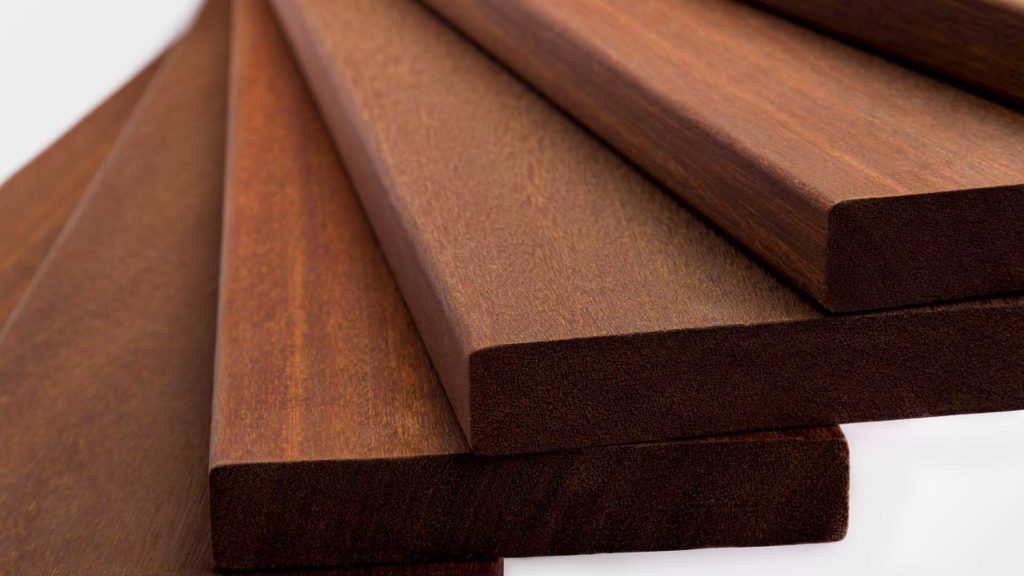
The following are the most popular species of mahogany wood available in most lumberyards and dealers.
Honduran Mahogany – Swietenia macrophylla
Honduran mahogany has many names but this is usually referred to as genuine mahogany. This distinguishes Honduran mahogany from other species found in Asia. Another very related mahogany species is the Khaya species growing in Africa.
The Honduran mahogany is very easy to work with. It is beautiful and very stable making it a favorite among woodworkers and furniture makers. Honduran mahogany is an essential commercial wood in Latin America. This species is extensively grown in huge plantations in Latin American countries.
- Distribution: Honduran mahogany comes from southern Mexico and central South America. This species is commonly grown on large plantations.
- Tree Dimensions: 150 to 200 feet tall and 3 to 6 feet in diameter
- Average Dried Weight: 36.8 pounds per cubic feet
- Specific Gravity: 0.52, 0.59
- Janka Hardness: 900 pounds-feet
- Color and Appearance: the Honduran mahogany heartwood color can change from pale pink-brown to dark red-brown. The color of Honduran mahogany changes as the wood ages.
- Grain or Texture: Honduran mahogany has a straight and interlocked grain, sometimes wavy or irregular. It has a medium texture with a moderately-natural shine.
- Resistance to Rotting: the Honduran mahogany has varying resistance to rotting, this depends on the density and the growing conditions. Heartwood is resistant to insects and termites but it may be vulnerable to other burrowing insects.
- Workability: Honduran mahogany is easy to work with using hand and machine tools. It can dull blade cutters and saws. The wood sands well and accepts glues, stains, and various finishes.
- Presence of Odor: Honduran mahogany has no distinguishing odor.
- Toxicity: some people can suffer from severe allergic reactions but these are uncommon. The allergic reactions include eye and skin irritation, respiratory issues, nausea, hypersensitivity issues, and many more.
- Availability: Honduran mahogany is available in lumber and veneer from large plantations. The price of this mahogany species is in the middle range for imported wood. This wood is more expensive compared to African mahogany. You can bet that quartersawn Honduran mahogany is the most expensive piece.
- Uses: Honduran mahogany is useful in making turned objects, furniture, veneer, cabinets, musical instruments, carvings, and boatbuilding.
Cuban Mahogany – Swietenia mahogani
Cuban mahogany is the most revered furniture and cabinet wood used around the world. This is extensively used in furniture making in Europe and the United States. There was a time that Cuban mahogany was harvested to point of extinction.
Cuba stopped all exporting of Cuban mahogany in 1946 because of over-harvesting and because of the increased demand. The low supply also prompted bans in the Caribbean. Cuban Mahogany is easy to work with, beautiful, and stable. These qualities have made it very popular in making furniture.
- Distribution: Cuban mahogany grows in the Caribbean and Southern Florida.
- Tree Dimensions: 65 to 100 feet tall and 3 to 5 feet in diameter.
- Average Dried Weight: 37 pounds per cubic feet
- Specific Gravity: .53, .60
- Janka Hardness: 930 pounds-feet
- Color and Appearance: Cuban mahogany has varying heartwood colors from pink-brown to red-brown. The denser the wood, the darker its heartwood color. Also, the color can darken as the wood ages.
- Grain or Texture: the grain texture of Cuban mahogany is straight, wavy, irregular, and interlocked. It comes with a medium texture with a moderate and uniform shine.
- Resistance to Rotting: Cuban mahogany is durable but the level of durability depends on the wood density and where the tree was grown. Older trees have darker and heavier lumber which is more durable. This mahogany species is resistant to insects and termites but is vulnerable to attacks from other insects.
- Workability: Cuban mahogany is easy to work with whether you’re using hand or power tools. You’ll experience a slight dulling of your blades and cutters. This wood is easy to glue, stain, turn, and finish.
- Presence of Odor: this wood has no specific odor.
- Toxicity: Cuban mahogany has been reported as a skin irritant. There are a handful of people who have suffered from severe allergic reactions.
- Availability: Cuban mahogany is no longer available commercially. There are still some small qualities of Cuban mahogany but are very expensive.
- Uses: this mahogany species is used to make turned objects, cabinets, furniture, veneers, musical instruments, carving, and boatbuilding.
Santos Mahogany – Myrixylon balsamum
Although Santos mahogany is called mahogany, it is not related to genuine mahogany and also to the Meliaceae family. Santos mahogany has the appearance of true mahogany but the lumber is denser, stronger, and harder making it complicated to work. The Santos mahogany trees are also called Balsamo and are useful in producing fragrances with Balsam of Peru.
- Distribution: Santos mahogany grows in Southern Mexico, Central America, and South America.
- Tree Dimensions: 65 to 100 feet tall and 2 to 3 feet wide
- Average Dried Weight: 57 pounds per cubic feet
- Specific Gravity: .74, .91
- Janka Hardness: 2400 pounds-feet
- Color and Appearance: Santos mahogany has a color variation from one board to another from light to dark purple-red. The grain color can become purple or red as the wood ages. You’ll find that the quartersawn sections of Santos mahogany have stripe or ribbon-like patterns.
- Grain or Texture: this wood has an interlocked grain with a moderate to fine texture. Expect a natural shine on the wood surface.
- Resistance to Rotting: Santos mahogany is very durable against decay but is not as good against insects and termites.
- Workability: Santos mahogany can cause a blunting effect on blades and cutting edges. It is very hard to work with because of its very high density and interlocked grain. It’s also hard to glue or stain but it finishes very well.
- Presence of Odor: this wood has a distinct spicy smell that’s evident when the wood is being worked. As we mentioned, this wood is integral in the creation of Balsam of Peru which is a perfume ingredient.
- Toxicity: some people have suffered from severe allergic reactions after working with Santos mahogany. Some people reported skin and respiratory issues.
- Availability: This is a wood in the mid-range price of imported lumber. The price is comparable to exotic hardwoods that are used in making floors like Ipe wood.
- Uses: Santos mahogany is used in heavy construction, flooring, furniture making, and in making interior trims.
African Mahogany – Khaya spp
The Khaya genus has several species which are native to Africa. This mahogany species lacks the red-brown hue and is not as durable as those belonging to the Swietenia genus.
- Distribution: African Mahogany is from West tropical Africa
- Tree Dimensions: 100 to 130 feet tall and 3.5 feet wide
- Average Dried Weight: 40 pounds per cubic feet
- Specific Gravity: .52, .64
- Janka Hardness: 1070 pounds-feet
- Color and Appearance: African mahogany has heartwood with a variable color from pale pink to deep red-brown. This wood comes with streaks that range from medium to dark-red brown. The color can grow darker as the wood ages. You’ll also notice that quartersawn wood can have a ribbon appearance.
- Grain or Texture: African mahogany has a straight to interlocked grain with a medium to coarse texture. This has a natural shine and produces a light-refracting optical phenomenon called chatoyancy.
- Resistance to Rotting: this wood is moderately durable but has moderate to poor borer or insect resistance.
- Workability: this wood is easy to work with and accepts finishes and glues better. You’ll experience tear-outs if the wood’s grain is interlocked.
- Presence of Odor: African mahogany has no specific odor when worked.
- Toxicity: Some people have reported severe allergic reactions. This wood is a sensitizer for eye, skin, and mucus membrane allergic reactions.
- Availability: African mahogany is available in many lumber sizes and is also in lumber, plywood, and veneer form. The price of African mahogany is low to moderate for imported lumber.
- Uses: African mahogany is used in plywood, furniture-making, turned objects, veneer, boat building, and in making interior trims.
Mountain Mahogany – Cercocarpus supp.
Mountain mahogany must not be confused with genuine mahogany that belongs to the Swietenia genus. This is an unrelated species to mahogany and is very dense. It is one of the densest trees that are found in the United States.
Mountain mahogany is a small tree growing at higher elevations. The harvesting of mountain mahogany is limited.
- Distribution: Mountain mahogany is common in the Western United States and the northern parts of Mexico.
- Tree Dimensions: 10 to 20 feet tall and 1 foot wide
- Average Dried Weight: 69 pounds per cubic feet
- Specific Gravity: .93, 1.11
- Janka Hardness: 3200 pounds-feet
- Color and Appearance: Mountain mahogany has a reddish brown heartwood with a pale yellow to pink sapwood. The color can become darker as the wood ages.
- Grain or Texture: Mountain mahogany has a very fine to even texture with a natural shine.
- Resistance to Rotting: there is no reported information on mountain mahogany when it comes to resistance to rotting and insects.
- Workability: this wood is very difficult to work with because of its density and resistance to cutting or sawing.
- Presence of Odor: there is also no characteristic smell when working with mountain mahogany.
- Toxicity: there are no reports of toxicity and health risks when working with mountain mahogany.
- Availability: this wood is not harvested for its lumber. It is available in small turning blanks but in very little amounts.
- Uses: this wood is commonly used as firewood, turned objects, and other small projects.
Swamp Mahogany – Eucalyptus robusta
Although swamp mahogany is called mahogany, it is related to the Eucalyptus species like the Blue Gum and Brown Mallee. This tree is native to Eastern Australia and is known for its density and strength.
- Distribution: Swamp mahogany is native to Eastern Australia
- Tree Dimensions: 65 to 100 feet tall and 2 to 3 feet wide
- Average Dried Weight: 49 pounds per cubic feet
- Specific Gravity: .60, .79
- Janka Hardness: 1250 pounds-feet
- Resistance to Rotting: Swamp mahogany is resistant to marine borers and insects.
- Uses: Swamp mahogany is commonly used in wood production, pulp, plywood, fuel, firewood, and fencing.
Philippine Mahogany
Philippine mahogany is also called lauan. This is a loose term for a large variety of the Shorea genus grown in Southeast Asian countries like the Philippines, Malaysia, and Singapore.
- Distribution: this mahogany is available in Southeast Asia
- Tree Dimensions: 200 feet tall and 6 feet wide
- Color and Appearance: the color ranges from red to dark red depending on the species. White meranti is yellow-brown.
- Grain or Texture: the grain is coarse with large pores. The pores often have deposits in them that shine when exposed to light.
- Resistance to Rotting: this wood is not resistant to rotting and insects.
- Workability: this wood is easy to work whether you’re using hand or machine tools. There is splintering along the end grain when it is cut with a saw. In some species, there is quick gumming of sandpaper and tools.
- Availability: this wood is readily available and is fairly priced.
- Uses: Philippine mahogany is useful in making furniture, joinery, plywood, cabinets, millwork, molding, flooring, and in general construction. The dark meranti variety is very durable and thus used to make decks.
How to Care for Mahogany Cutting Boards?
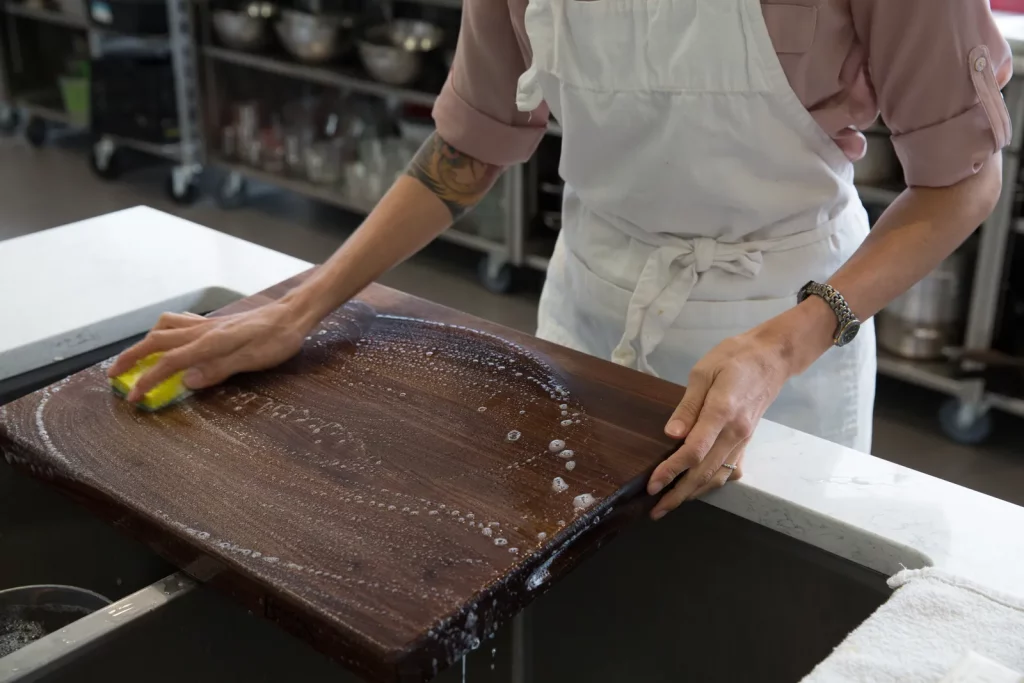
Mahogany cutting boards need a little more TLC. Although mahogany wood is softer than other woods, adding a protective finish to cutting boards can extend its life. To clean and care for mahogany boards as well as other types of wooden cutting boards, consider the following:
- Wash your mahogany cutting board by hand. Don’t place it inside the dishwasher.
- Wipe the board clean if you’re slicing bread or any dry items
- Clean the board well if you’re cutting or slicing moist, pungent, and sticky food items.
- Use liquid dishwashing soap when washing the cutting board. Always rinse the board very well after using soap.
- The best way to dry a cutting board is by air-drying from the side.
- Avoid soaking a wooden cutting board in water as this can cause the wood to warp. Go for a quick dunk only and then dry the board completely.
- Do not wash the cutting boards in a dishwasher. The wood may dry out, crack or warp due to intense heat and chemicals used in dishwashing detergent.
- Before cutting vegetables or meat, wipe the surface more frequently with a sponge. Frequent wiping will make cutting board cleanup much easier later.
Be sure to wash your cutting boards as soon as you’re done. This is because food, liquid, and smells will penetrate the pores of the wood. If you overlook this, the smell and taste of previously cooked food can transfer to the food you’re currently cutting and ruin its taste and smell.
Always sanitize wooden cutting boards after using them to cut raw meat. Don’t use harsh chemicals, you can use white vinegar or bleach and a water solution composed of 1 ½ teaspoon of bleach mixed with 4 cups of water.
Wooden boards can accumulate smells over time. You can remove the smell by rubbing a small piece of lemon over its surface. Let the lemon juice remain on the surface for about a minute and then wipe the board or rinse it completely.
Sometimes wooden cutting boards can accumulate stains after extensive use. To remove these stains, place the baking soda on it and rub it with a damp cloth. Once the stain has been removed, rinse the area with water to remove any excess baking soda.
How to Oil a Mahogany Cutting Board?
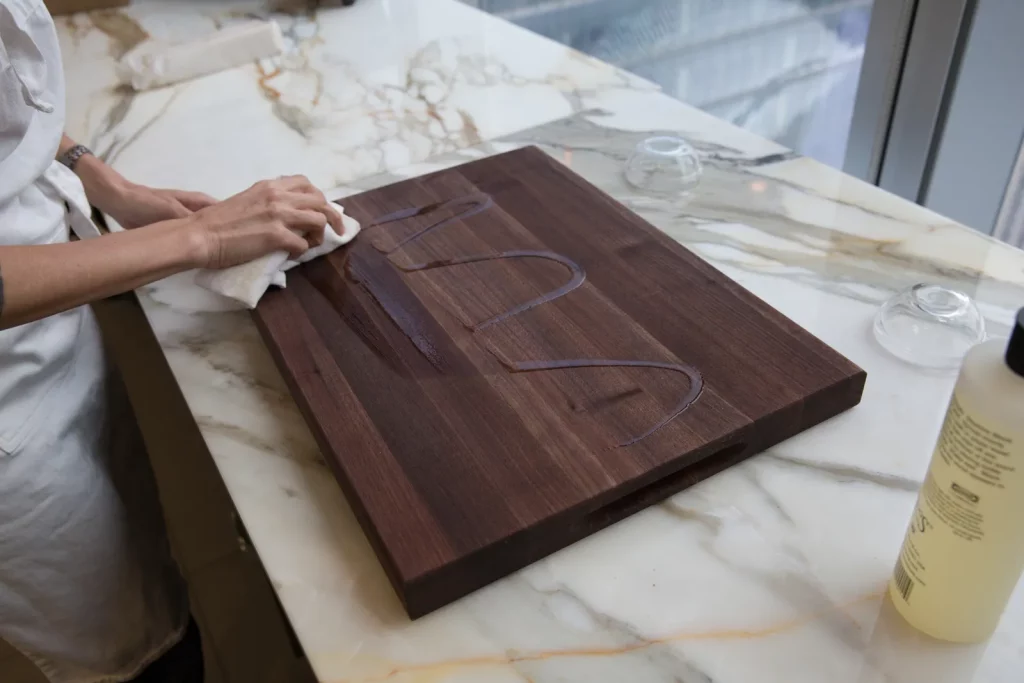
Applying oil on a wooden cutting board is as important as adding conditioner to your hair. It helps protect the board from moisture and odors from food. Also, well-oiled cutting boards are protected against microorganisms like bacteria and fungi.
Oiled mahogany cutting boards are protected against splitting and warping. When a wood warps, the surface becomes unstable and thus, it would be dangerous to chop on it. Also, the small splits and cuts can cause moisture to seep in together with food particles which can harbor bacteria.
The best oil for cutting boards is mineral oils or beeswax oil. These natural oils will keep your board in good shape even after many years of use. Do not use cooking oils such as vegetable oil, animal oil, coconut oil, or palm oil as these can become rancid over time. Rancid oil is smelly and will stick to the surface of the cutting board.
Use food-grade mineral oil like Vaseline and paraffin. Do not use industrial-based mineral oil as this is not food-grade oil. You’ll find mineral oils in grocery stores or from a drugstore.
Final Words
Mahogany is good as a cutting board but it’s not the best kind. Mahogany is softer and less dense than other boards. It has large pores which can harbor food particles, dust, grime, and bacteria plus, the surface can accumulate marks and dents too.
But if you were to use mahogany wood as a cutting board, make sure to care for it and oil it to ensure good shape. There are many species and types of mahogany wood. Select one that will match your needs.
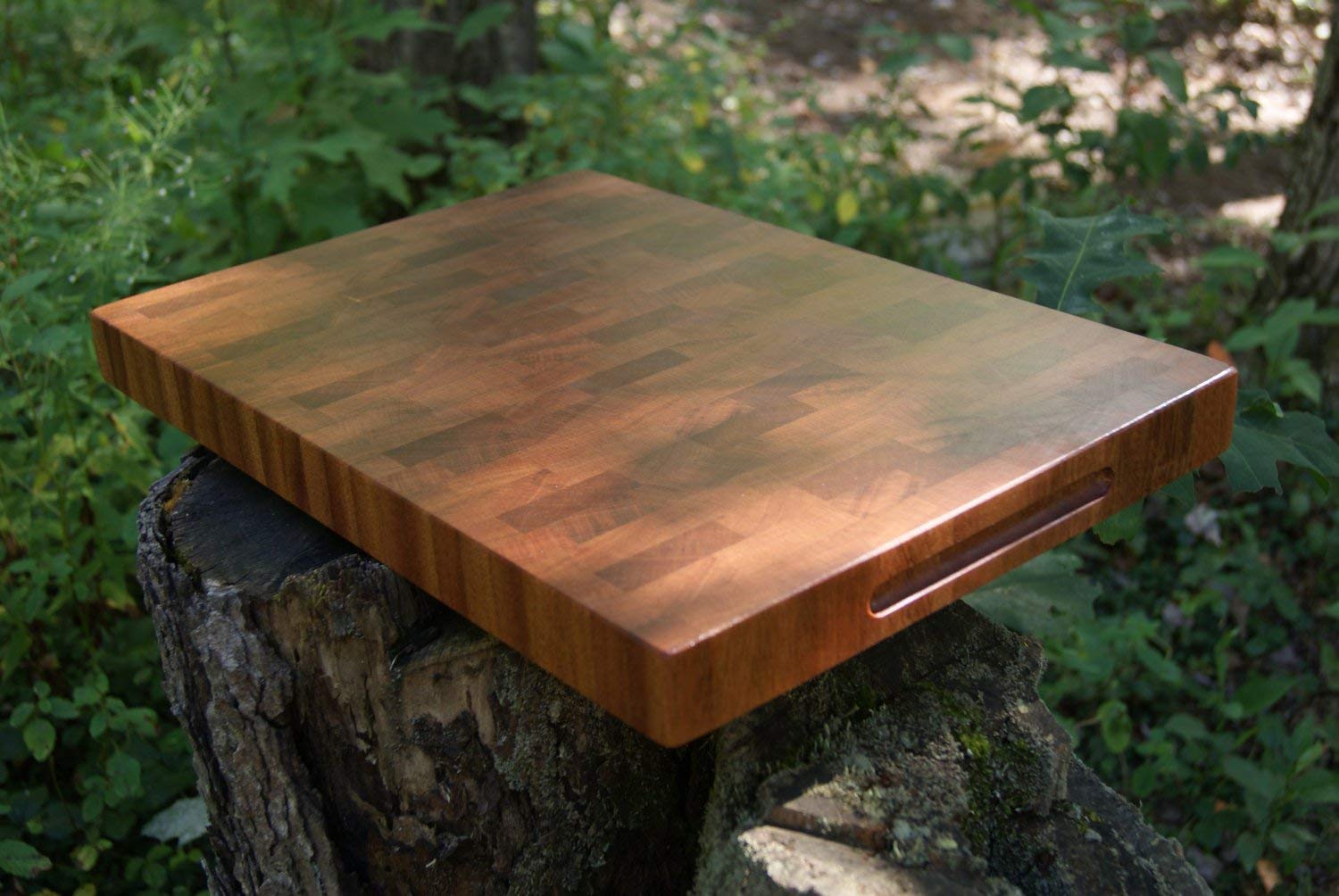
Leave a Reply